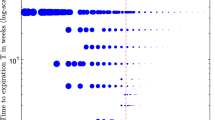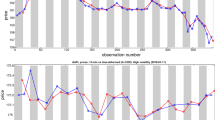Abstract
In this paper, we perform robustness and sensitivity analysis of several continuous-time stochastic volatility (SV) models with respect to the process of market calibration. The analyses should validate the hypothesis on importance of the jump part in the underlying model dynamics. Also an impact of the long memory parameter is measured for the approximative fractional SV model (FSV). For the first time, the robustness of calibrated models is measured using bootstrapping methods on market data and Monte Carlo filtering techniques. In contrast to several other sensitivity analysis approaches for SV models, the newly proposed methodology does not require independence of calibrated parameters—an assumption that is typically not satisfied in practice. Empirical study is performed on a data set of Apple Inc. equity options traded in four different days in April and May 2015. In particular, the results for Heston, Bates and approximative FSV models are provided.









Similar content being viewed by others
Notes
For more details on the arbitrage pricing see, for instance, Shreve (2004).
Alternatively one can estimate the parameters from time-series data.
The weight functions introduced by Mrázek et al. (2016) were considered.
For instance, if \(N = 6\) one might obtain \(\mathbf{X}^{\dagger } = (X_2, X_1,X_4,X_4,X_3,X_2)\) where \(X_j=(K_j,T_j)\).
For more details on Monte Carlo filtering approaches see, for instance Saltelli et al. (2008).
In this case, we will not be able to decide whether the parameters lead to a good or bad description of the modelled market.
For all trials we use “standard” \(\alpha = 5\%\) level of significance. In most of the trials we could have even lower \(\alpha \) and still we would reject the null hypothesis.
See, e.g., www.mathworks.com/help/stats/kstest2.html.
All results and data are available in supplementary materials.
References
Barndorff-Nielsen OE, Shephard N (2006) Econometrics of testing for jumps in financial economics using bipower variation. J Financ Econom 4(1):1–30. https://doi.org/10.1093/jjfinec/nbi022
Bates DS (1996) Jumps and stochastic volatility: exchange rate processes implicit in Deutsche mark options. Rev Financ Stud 9(1):69–107. https://doi.org/10.1093/rfs/9.1.69
Baustian F, Mrázek M, Pospíšil J, Sobotka T (2017) Unifying pricing formula for several stochastic volatility models with jumps. Appl Stoch Models Bus Ind 33(4):422–442. https://doi.org/10.1002/asmb.2248
Bayer C, Friz P, Gatheral J (2016) Pricing under rough volatility. Quant Finance 16(6):887–904. https://doi.org/10.1080/14697688.2015.1099717
Benhamou E, Gobet E, Miri M (2010) Time dependent Heston model. SIAM J Financ Math 1(1):289–325. https://doi.org/10.1137/090753814
Bianchetti M, Kucherenko S, Scoleri S (2015) Pricing and risk management with high-dimensional quasi Monte Carlo and global sensitivity analysis. Wilmott 2015(78):46–70. https://doi.org/10.1002/wilm.10434
Black FS, Scholes MS (1973) The pricing of options and corporate liabilities. J Polit Econ 81(3):637–654. https://doi.org/10.1086/260062
Campolongo F, Cariboni J, Schoutens W (2006) The importance of jumps in pricing European options. Reliab Eng Syst Saf 91(10):1148–1154. https://doi.org/10.1016/j.ress.2005.11.016
Carr P, Wu L (2003) What type of process underlies options? A simple robust test. J Finance 58(6):2581–2610. https://doi.org/10.1046/j.1540-6261.2003.00616.x
Chernick MR (2008) Bootstrap methods: a guide for practitioners and researchers, 2nd edn. Wiley series in probability and statistics. Wiley, Hoboken
Christoffersen P, Heston S, Jacobs K (2009) The shape and term structure of the index option smirk: why multifactor stochastic volatility models work so well. Manag Sci 55(12):1914–1932. https://doi.org/10.1287/mnsc.1090.1065
Creel M, Kristensen D (2015) ABC of SV: Limited information likelihood inference in stochastic volatility jump-diffusion models. J Empir Finance 31:85–108. https://doi.org/10.1016/j.jempfin.2015.01.002
De Marco S, Martini C (2012) The term structure of implied volatility in symmetric models with applications to Heston. Int J Theor Appl Finance 15(04):1250,026. https://doi.org/10.1142/S0219024912500264
Detlefsen K, Härdle WK (2007) Calibration risk for exotic options. J Deriv 14(4):47–63. https://doi.org/10.3905/jod.2007.686422
Duffie D, Pan J, Singleton K (2000) Transform analysis and asset pricing for affine jump-diffusions. Econometrica 68(6):1343–1376. https://doi.org/10.1111/1468-0262.00164
Efron B (1979) Bootstrap methods: another look at the jackknife. Ann Stat 7(1):1–26
Efron B (1982) The jackknife, the bootstrap and other resampling plans, CBMS-NSF Regional Conference Series in Applied Mathematics, vol 38. Society for Industrial and Applied Mathematics (SIAM), Philadelphia, PA
Elices A (2008) Models with time-dependent parameters using transform methods: application to Heston’s model. arXiv:0708.2020
Fukasawa M (2011) Asymptotic analysis for stochastic volatility: martingale expansion. Finance Stoch 15(4):635–654. https://doi.org/10.1007/s00780-010-0136-6
Hájek J, Šidák Z, Sen PK (1999) Theory of rank tests, 2nd edn. Probability and mathematical statistics. Academic Press Inc., San Diego
Heston SL (1993) A closed-form solution for options with stochastic volatility with applications to bond and currency options. Rev Financ Stud 6(2):327–343. https://doi.org/10.1093/rfs/6.2.327
Hwang E, Shin DW (2014) A bootstrap test for jumps in financial economics. Econom Lett 125(1):74–78. https://doi.org/10.1016/j.econlet.2014.08.024
Kim PJ (1976) The smirnov distribution. Ann Inst Stat Math 28(1):267–275. https://doi.org/10.1007/BF02504745
Lewis AL (2000) Option valuation under stochastic volatility: with mathematica code. Finance Press, Newport Beach
Mikhailov S, Nögel U (2003) Heston’s stochastic volatility model—implementation, calibration and some extensions. Wilmott Mag 2003(July):74–79
Mrázek M, Pospíšil J, Sobotka T (2016) On calibration of stochastic and fractional stochastic volatility models. Eur J Oper Res 254(3):1036–1046. https://doi.org/10.1016/j.ejor.2016.04.033
Osajima Y (2007) The asymptotic expansion formula of implied volatility for dynamic SABR model and FX hybrid model. https://doi.org/10.2139/ssrn.965265
Pospíšil J, Sobotka T (2016) Market calibration under a long memory stochastic volatility model. Appl Math Finance 23(5):323–343. https://doi.org/10.1080/1350486X.2017.1279977
Saltelli A, Tarantola S, Campolongo F, Ratto M (2004) Sensitivity analysis in practice: a guide to assessing scientific models. Wiley, Chichester
Saltelli A, Ratto M, Andres T, Campolongo F, Cariboni J, Gatelli D, Saisana M, Tarantola S (2008) Global sensitivity analysis: the primer. Wiley, Chichester
Senger O, Celik AK (2013) A Monte Carlo simulation study for Kolmogorov–Smirnov two-sample test under the precondition of heterogeneity: upon the changes on the probabilities of statistical power and type I error rates with respect to skewness measure. J Stat Econom Methods 2(4):1–16
Shreve SE (2004) Stochastic calculus for finance. Springer Finance. Springer, New York
Yekutieli I (2004) Implementation of the Heston model for the pricing of FX options. Tech. rep, Bloomberg LP
Acknowledgements
This work was supported by the GACR Grant 14-11559S Analysis of Fractional Stochastic Volatility Models and their Grid Implementation. Computational resources were provided by the CESNET LM2015042 and the CERIT Scientific Cloud LM2015085, provided under the programme “Projects of Large Research, Development, and Innovations Infrastructures”.
Author information
Authors and Affiliations
Corresponding author
Ethics declarations
Conflict of interest
The authors declare that they have no conflict of interest.
Ethical approval
This article does not contain any studies with human participants or animals performed by any of the authors.
Rights and permissions
About this article
Cite this article
Pospíšil, J., Sobotka, T. & Ziegler, P. Robustness and sensitivity analyses for stochastic volatility models under uncertain data structure. Empir Econ 57, 1935–1958 (2019). https://doi.org/10.1007/s00181-018-1535-3
Received:
Accepted:
Published:
Issue Date:
DOI: https://doi.org/10.1007/s00181-018-1535-3
Keywords
- Robustness analysis
- Sensitivity analysis
- Stochastic volatility models
- Bootstrapping
- Monte Carlo filtering




